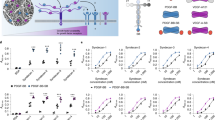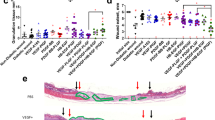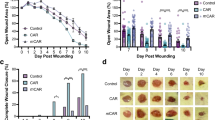Abstract
The activity of fibroblast growth factor 2 (FGF-2) is stringently controlled. Inactive in undisturbed tissues, it is activated during injury and is critical for tissue repair. We find that this control can be imposed by the soluble syndecan-1 ectodomain, a heparan sulfate proteoglycan shed from cell surfaces into wound fluids. The ectodomain potently inhibits heparin-mediated FGF-2 mitogenicity because of the poorly sulfated domains in its heparin sulfate chains. Degradation of these regions by platelet heparanase produces heparin-like heparin sulfate fragments that markedly activate FGF-2 mitogenicity and are found in wound fluids. These results establish a novel physiological control for FGF-2 and suggest new ways to modulate FGF activity.
This is a preview of subscription content, access via your institution
Access options
Subscribe to this journal
Receive 12 print issues and online access
$209.00 per year
only $17.42 per issue
Buy this article
- Purchase on Springer Link
- Instant access to full article PDF
Prices may be subject to local taxes which are calculated during checkout
Similar content being viewed by others
References
Zhou, M. et al. Fibroblast growth factor 2 control of vascular tone. Nature Med. 4, 201–207 (1998).
Mason, I.J. The ins and outs of fibroblast growth factors. Cell 78, 547–552 (1994).
Bashkin, P. et al. Basic fibroblast growth factor binds to subendothelial extracellular matrix and is released by heparitinase and heparin-like molecules. Biochemistry 28, 1737–1743 (1989).
Folkman, J. et al. A heparin-binding angiogenic protein-basic fibroblast growth factor is stored within basement membrane. Am. J. Pathol. 130, 393–399 (1988).
Gonzalez, A.M., Buscaglia, M., Ong, M. & Baird, A. Distribution of basic fibroblast growth factor in the 18-day rat fetus: localization in the basement membranes of diverse tissues. J. Cell Biol. 110, 753–765 (1990).
Flaumenhaft, R. & Rifkin, D.B. The extracellular regulation of growth factor action. Mol. Biol. Cell 3, 1057–1065 (1992).
Abraham, J.A. & Klagsbrun, M. in The Molecular and Cellular Biology of Wound Repair (ed. Clark, R.A.F.) 195–248 (Plenum, New York, 1996).
Schlessinger, J., Lax, I. & Lemmon, M. Regulation of growth factor activation by proteoglycans: what is the role of the low affinity receptors. Cell 83, 357–360 (1995).
Klagsbrun, M. & Baird, A. A dual receptor system is required for basic fibroblast growth factor activity. Cell 67, 229–231 (1991).
Bernfield, M. et al. Biology of the syndecans: a family of transmembrane heparan sulfate proteoglycans. Annu. Rev. Cell Biol. 8, 365–398 (1992).
Humphries, D.E. & Stevens, R.L. in Heparin and Related Polysaccharides (eds. Lane, D.A., Björk, I. & Lindahl, U.) 59–67 (Plenum, New York, 1992).
Steinfeld, R., Van Den Berghe, H. & David, C. Stimulation of fibroblast growth factor receptor-1 occupancy and signalling by cell surface-associated syndecans and glypican. J. Cell Biol. 133, 405–416 (1996).
Rose-John, S. & Heinrich, P.C. Soluble receptors for cytokines and growth factors: generation and biological function. Biochem. J. 300, 281–290 (1994).
Subramanian, S.V., Fitzgerald, M.L. & Bernfield, M. Regulated shedding of syndecan-1 and -4 ectodomains by thrombin and growth factor receptor activation. J. Biol. Chem. 272, 14713–14720 (1997).
Moscatelli, D. Basic fibroblast growth factor (bFCF) dissociates rapidly from heparan sulfates but slowly from receptors - Implications for mechanisms of bFGF release from the pericellular matrix. J. Biol. Chem. 267, 25803–25809 (1992).
Ornitz, D.M. et al. Heparin is required for cell-free binding of basic fibroblast growth factor to a soluble receptor and for mitogenesis in whole cells. Mol. Cell. Biol. 12, 240–247 (1992).
Kato, M., Wang, H., Bernfield, M., Gallagher, J.T. & Turnbull, J.E. Cell surface syndecan-1 on distinct cell types differs in fine structure and ligand binding of its heparan sulfate chains. J. Biol. Chem. 269, 1881–1890 (1994).
Hoogewerf, A.J. et al. CXC chemokines connective tissue activating peptide-lll and neutrophil activating peptide-2 are heparin/heparan sulfate-degrading enzymes. J. Biol. Chem. 270, 3268–3277 (1995).
Shively, J.E. & Conrad, H.E. Formation of anhydrosugars in the chemical depoly-merization of heparin. Biochemistry 15, 3932–3942 (1976).
Aviezer, D. et al. Perlecan, basal lamina proteoglycan, promotes basic fibroblast growth factor-receptor binding, mitogenesis, and angiogenesis. Cell 79, 1005–1013 (1994a).
Aviezer, D. et al. Differential structural requirements of heparin and heparan sulfate proteogycans that promote binding of basic fibroblast growth factor to its receptor. J. Biol. Chem. 269, 114–121 (1994b).
Stringer, S.E. & Gallagher, J.T. Heparan Sulphate. Int. J. Biochem. Cell Biol. 29 (5), 709–714 (1997).
Linhardt, R.J., Turnbull, J.E., Wang, H.M., Loganathan, D. & Gallagher, J.T. Examination of the substrate specificity of heparin and heparan sulfate lyases. Biochemistry 29, 2611–2617 (1990).
Wang, H. et al. Glycosaminoglycans can influence fibroblast growth factor-2 mitogenicity without significant growth factor binding. Biochem. Biophys. Res. Commun. 235, 369–373 (1997). Erratum. Biochem. Biophys. Res. Commun. 242, 248 (1998).
Celli, G., LaRochelle, W.J., Mackern, S., Sharp, R. & Merlino, G. Soluble dominant-negative receptor uncovers essential roles for fibroblast growth factors in multi-organ induction and patterning. EMBO J. 17, 1642–1655 (1998).
Mali, M., Andtfolk, H., Miettinen, H.M. & Jalkanen, M. Suppression of tumor cell growth by syndecan-1 ectodomain. J. Biol. Chem. 269, 27795–27798 (1994).
Castellot, J.J., Addonizio, M.L., Rosenberg, R.D. & Karnovsky, M.J. Cultured endothelial cells produce a heparin-like inhibitor of smooth muscle cell growth. J. Cell Biol. 90, 372–379 (1981).
Frize, L.M.S., Reilly, C.F. & Rosenberg, R.D. An antiproliferative heparan sulfate species produced by postconfluent smooth muscle cells. J. Cell Biol. 100, 1041–1049 (1985).
Benitz, W.E., Kelley, R.T., Anderson, C.M., Lorant, D.E. & Bernfield, M. Endothelial heparan sulfate proteoglycan. I. Inhibitory effects on smooth muscle cell proliferation. Am. J. Resp. Cell Mol. Biol. 2, 13–24 (1990).
Nugent, M.A., Karnovsky, M.J. & Edelman, E.R. Vascular cell-derived heparan sulfate shows coupled inhibition of basic fibroblast growth factor building and mitogenesis in vascular smooth muscle cells. Circ. Res. 73, 1051–1060 (1993).
Forsten, K.E., Courant, N.A. & Nugent, M.A. Endothelial proteoglycans inhibit bFGF binding and mitogenesis. J. Cell. Phys. 172, 209–220 (1997).
Hiscock, D.R., Canfield, A. & Gallagher, J.T. Molecular structure of heparan sulphate synthesized by bovine aortic endothelial cells. Biochim. Biophys. Acta 1244, 104–112 (1995).
Ishai-Michaeli, R., Eldor, A. & Vlodavsky, I. Heparanase activity expressed by platelets, neutrophils, and lymphoma cells releases active fibroblast growth factor from extracellular matrix. Cell Regul. 1, 833–842 (1990).
Matzner, Y., Vlodavsky, I., Bar-Ner, M., Ishai-Michaeli, R. & Tauber, A. Subcellular localization of heparanase in human neutrophils. J. Leukoc. Biol. 51, 519–524 (1992).
Guimond, S., Maccarana, M., Olwin, B.B., Lindahl, U. & Rapraeger, A.C. Activating and inhibitory heparin seqeunces for FGF-2 (basic FGF). Distinct requirements for FGF-1, FGF-2, and FGF-4. J. Biol. Chem. 268, 23906–23914 (1993).
Walker, A., Turnbull, J.E. & Gallager, J.T. Specific heparan sulfate saccharides mediate the activity of basic fibriblast growth factor. J. Biol. Chem. 269, 931–935 (1994).
Gilat, D. et al. Molecular behavior adapts to context: Heparanase functions as an extracellular matrix-degrading enzyme or as a T Cell adhesion molecule, depending on the local pH. J. Exp. Med. 181, 1929–1934 (1995).
Ernst, S., Langer, R., Cooney, C. & Sasisekharan, R. Enzymatic degradation of glycosaminoglycans. Crit. Rev. Biochem. Mol. Biol. 30, 387–444 (1995).
Elenius, K. et al. Induced expression of syndecan in healing wounds. J. Cell Biol. 114, 585–595 (1991).
Gallo, R.L. et al. Syndecans, cell surface heparan sulfate proteoglycans, are induced by a proline-rich antimicrobial peptide from wounds. Proc. Natl. Acad. Sci. USA 91, 11035–11039 (1994).
Gallagher, J.T., Turnbull, J.E. & Lyon, M. Patterns of sulphation in heparan sulphate: polymorphism based on a common structural theme. Int. J. Biochem. 24, 553–560 (1992).
Venkataraman, G. et al. Preferential self-association of basic fibroblast growth factor is stabilized by heparin during receptor dimerization and activation. Proc. Natl. Acad. Sci. USA 93, 845–850 (1996).
Faham, S., Hileman, R.E., Fromm, J.R., Linhardt, R.J. & Rees, D.C. Heparin structure and interactions with basic fibroblast growth factor. Science 271, 1116–1122 (1996).
Ornitz, D.M. et al. FGF binding and FGF receptor activation by synthetic he-parin-derived di- and trisaccharides. Science 268, 432–436 (1995).
Koda, J.E., Rapraeger, A. & Bernfield, M. Heparan sulfate proteoglycans from mouse mammary epithelial cells: Cell surface proteoglycan as a receptor for interstitial collagens. J. Biol. Chem. 260, 8157–8162 (1985).
Saunders, S. & Bernfield, M. Cell surface proteoglycan binds mouse mammary epithelial cells to fibronectin and behaves as a receptor on epithelial for interstitial matrix. J. Cell Biol. 106, 423–430 (1988).
Jalkanen, M., Rapraeger, A., Saunders, S. & Bernfield, M. Cell surface proteoglycan of mouse mammary epithelial cells is shed by cleavage of its matrix-binding ectodomain from its membrane-associated domain. J. Cell Biol. 105, 3087–3096 (1987).
Jalkanen, M., Nguyen, H., Rapraeger, A., Kurn, N. & Bernfield, M. Heparan sulfate proteoglycans from mouse mammary epithelial cells: Localization on the cell surface with a monoclonal antibody. J. Cell Biol. 101, 976–984 (1985).
Author information
Authors and Affiliations
Rights and permissions
About this article
Cite this article
Kato, M., Wang, H., Kainulainen, V. et al. Physiological degradation converts the soluble syndecan-1 ectodomain from an inhibitor to a potent activator of FGF-2. Nat Med 4, 691–697 (1998). https://doi.org/10.1038/nm0698-691
Received:
Accepted:
Issue Date:
DOI: https://doi.org/10.1038/nm0698-691
This article is cited by
-
Heparanase: a potential marker of worse prognosis in estrogen receptor-positive breast cancer
npj Breast Cancer (2021)
-
Sorsby Fundus Dystrophy Mutation in Tissue Inhibitor of Metalloproteinase 3 (TIMP3) promotes Choroidal Neovascularization via a Fibroblast Growth Factor-dependent Mechanism
Scientific Reports (2019)
-
Prognostic role of immune infiltrates in breast ductal carcinoma in situ
Breast Cancer Research and Treatment (2019)
-
Suppressive effect of syndecan ectodomains and N-desulfated heparins on osteoclastogenesis via direct binding to macrophage-colony stimulating factor
Cell Death & Disease (2018)



